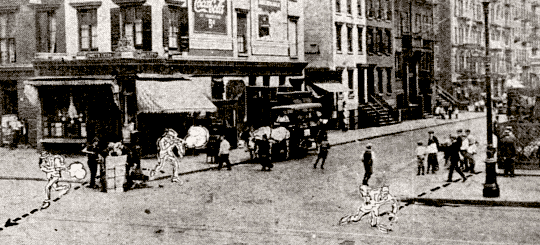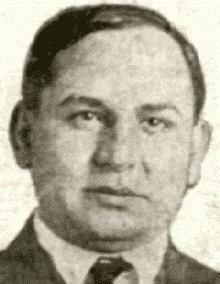Media quickly lost interest in
Connecticut girl caught up in
New York City underworld hit
Connecticut girl caught up in
New York City underworld hit
When Mafia assassins opened fire in a crowded Manhattan intersection at midday, Aug. 11, 1922, they inflicted a mortal wound on their target but also wounded two bystanders.
The intended victim, Umberto Valente, died an hour later at St. Mark's Hospital. A young girl and a municipal street cleaner - "collateral damage" in the hit - were rushed to Bellevue Hospital for treatment of gunshot wounds.
 |
| Agnes Egglinger |
Newspapers in New York City and around the country told of Agnes being struck by a stray slug in the right chest. The New York Daily News, "New York's Picture Newspaper," ran a photograph of the girl. The papers said the young girl might lose her life. It appears, however, that no one in the media thought of following up to see whether Agnes survived.
Public records indicate that she did. Federal and state census records show Agnes becoming an adult, and state records appear to show her marriage as well as her death.
Agnes was the third child - and first daughter - born to Harry and Erna Schultz Egglinger of Jamaica, Queens, New York. At least two additional siblings were born after her. Harry worked as a metal lathe operator. The Egglinger family moved in 1919 from Queens to New Haven, Connecticut, first settling at 34 Sylvan Avenue and later moving about a mile south to 42 Hurlbut Street. While in New Haven, Erna's younger brother Reinhold Schultz, Jr., - Agnes' Uncle Reinhold - lived with the family as a boarder.
 |
| New York Daily News, Aug. 12, 1922. Scene of the attack on Valente. |
In early August of 1922, the Egglingers went to visit Erna's father, Reinhold Schultz, Sr., at his Manhattan home, 232 East Twelfth Street. They were a few days into their visit when a feud within the New York City Mafia erupted in gunfire at the intersection of East Twelfth Street and Second Avenue.
Agnes and her four-year-old sister Dorothy were playing on the sidewalk, as gunmen loyal to Manhattan gang boss Giuseppe Masseria murdered Umberto Valente. Valente, a trusted assassin of Brooklyn-based Mafia boss of bosses Salvatore "Toto" D'Aquila, had failed in an assassination attempt against Masseria just three days earlier (a half-dozen striking garment workers were wounded - at least one fatally - when their group got in the way of the getaway car and mobsters fired at the ground to disperse them). Little Dorothy was fortunate to escape injury as the bullets flew on August 11; reports stated that a slug passed through the fabric of her dress.
 |
| Masseria |
A decade later, eighteen years from the shooting that nearly cost Agnes her life, the 1940 U.S. Census found the twenty-eight-year-old in her parents' home on 153rd Street. Her two younger siblings were also still in the household, and an older brother was renting rooms in the house for himself, his wife and their young son. Agnes was working as a clerk in an insurance office.
While available records are not definitive, it appears that the Agnes Egglinger who was accidentally shot in the summer of 1922 was the same Agnes Egglinger who became the wife of Frank Seelinger in Queens in late September of 1946. It could be argued that marriage was a greater threat to her health than a bullet. Records show that Agnes Seelinger died in July 1949 - twenty-seven years after the nearly fatal gunshot wound and less than three years after taking her wedding vows.
Sources:
- "1 dead, 2 shot, as bootleggers again fight on East Side," Brooklyn Daily Eagle, Aug. 11, 1922, p. 1.
- "Bootleggers at war," Philadelphia Inquirer, Aug. 12, 1922, p. 2.
- "Cloakmaker, victim of gunman, dies; 3 more in hospital," Brooklyn Daily Eagle, Aug. 9, 1922, p. 20.
- "East Side bad man killed as shots fly," New York Herald, Aug. 12, 1922, p. 16.
- "Eight men shot in mysterious battle on street," Brooklyn Daily Eagle, Aug. 8, 1922, p. 1.
- "Gang kills gunman; 2 bystanders hit," New York Times, Aug. 12, 1922, p. 20.
- "Gunman's volley fatal to striker," New York Times, Aug. 10, 1922, p. 13.
- "Gunmen shoot six in East Side swarm," New York Times, Aug. 9, 1922, p. 1.
- "Man dies from bullet, girl is seriously hurt," New York Evening Telegram, Aug. 11, 1922, p. 1.
- "Mystery in rum street battle near solution," New York Tribune, Aug. 12, 1922, p. 16.
- "New Haven girl wounded in New York bootleggers' feud," Bridgeport CT Telegram, Aug. 12, 1922, p. 1.
- "One killed, two shot in pistol battle," Brooklyn Standard Union, Aug. 11, 1922, p. 1.
- "One man killed, two wounded, in gang war," New York Call, Aug. 12, 1922, p. 4.
- "Three shot down in crowd in East Side gang warfare," New York Evening World, Aug. 11, 1922, p. 1.
- "Valente's arrest balked by murder," New York Evening World, Aug. 12, 1922, p. 3.
- New York City Death Index, certificate no. 8666, July 3, 1949.
- New York City Marriage License Index, license no. 10522, Sept. 28, 1946.
- New York State Census of 1915, Queens County, Jamaica village, Assembly District 4, Election District 27, Ward 4.
- New York State Census of 1925, Queens County, Baisley Park village, Assembly District 4, Election District 36, Ward 4.
- United States Census of 1920, Connecticut, New Haven County, City of New Haven, Enumeration District 505.
- United States Census of 1930, New York State, Queens County, Baisley Park, Assembly District 4, Enumeration District 41-376.
- United States Census of 1940, New York State, Queens County, Enumeration District 41-1287B.
See also:




